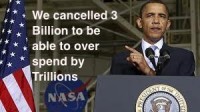By Dr. Ileana Johnson Paugh ——Bio and Archives--April 3, 2012
Cover Story | CFP Comments | Reader Friendly | Subscribe | Email Us
 It is not often that I can watch an entire segment of “60 minutes,” but I was riveted this past Sunday by their coverage of the last space shuttle flight and the economic and political repercussions for the Brevard area and for our nation.
Person after person interviewed were sad or in tears about the deliberate destruction of our country, of our economy, and of our technological edge and the ability to defend ourselves.
It is not often that I can watch an entire segment of “60 minutes,” but I was riveted this past Sunday by their coverage of the last space shuttle flight and the economic and political repercussions for the Brevard area and for our nation.
Person after person interviewed were sad or in tears about the deliberate destruction of our country, of our economy, and of our technological edge and the ability to defend ourselves.“I'm gonna ensure that our space program doesn't suffer when the shuttle goes out of service by making sure that all those who work in the space industry in Florida do not lose their jobs when the shuttle is retired because we can't afford to lose their expertise.Mike Carpenter was shocked when President Obama cancelled Constellation in 2010 and turned over development of a new spaceship program to private entrepreneurs. “Well, we were lied to when Obama came through, gave us a lot of hope and supposedly a lot of change. Well, I've got change in my pocket, but the hope is gone.” (60 Minutes) Congress cut the funding for the Obama plan in half, delaying any possible space flights by Americans by at least five years. The first shuttle flight occurred on April 21, 1981. Columbia, Challenger, Discovery, Atlantis, and Endeavour’s numerous missions carried people into orbit, launched, recovered, and repaired satellites, built the International Space Station, and conducted cutting-edge research. The greatest feat of engineering, the shuttle weighed at liftoff four and a half million pounds and reached a top speed of 17,000 miles per hour. The discovery of advanced technology, the result of intense research and development, involved a vast workforce of military personnel, civilians, and contractors. The shuttle missions ended on July 21, 2011, with the STS-135 flight of Atlantis. Atlantis will remain at the Kennedy Space Center. She flew 33 missions although she was designed for 100. Scott Pelley said, “Like so many in Brevard County, Florida, she was pulled from the service to her country, long before she was ready.” The remaining shuttles will be displayed in museums across the country. Sammy Rivera, who worked for NASA for 26 years reviewing engineering drawings, said: “This is my country. And I can’t let it go down without a fight.” (60 Minutes)
View Comments
Dr. Ileana Johnson Paugh, Ileana Writes is a freelance writer, author, radio commentator, and speaker. Her books, “Echoes of Communism”, “Liberty on Life Support” and “U.N. Agenda 21: Environmental Piracy,” “Communism 2.0: 25 Years Later” are available at Amazon in paperback and Kindle.